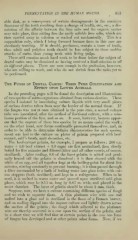Page 803 - My FlipBook
P. 803
FERMENTATION IN THE HUMAN MOUTH. 813 ;
al)le that, as a consequence of certain derangements in the nutritive
functions of the teeth resulting from a change of health, etc., etc., a dis-
solution of the affinity between the, lime salts and the organic matter
mav take place, thus setting free the easily soluble lime salts, which are
then carried away in solution or washed out mechanically. This is a
supposition only, which I bring forward because facts in this case are
absolutely wanting. If it should, perchance, contain a trace of truth,
then adult and pulpless teeth should be less subject to these sudden
attacks of caries than young teeth with living pulps.
There still remains much hard work to be done before the subject of
dental caries may be dismissed as having received a final solution in all
its different phases. There are men enough in the profession, however,
w^ho are willing to work, and who do not shrink from the tasks, yet to
be performed.
The Fungi of Dental Caries : Their Pure Cultivation and
Effect upon Lower Animals.
In the preceding pages will be found the description and illustrations
of two species of micro-organisms obtained from carious dentine. These
species I isolated by inoculating culture liquids with very small pieces
of carious dentine taken from near the border of the normal tissue. If
the fungus was not at once obtained in tlie pure state, a second culture
tube was inoculated, after the method of fractional culture, with a min-
imum portion of the first, and so on. It soon, however, became appar-
ent that the capture of these two species by no means ended the work
on the other hand, new forms continually presented themselves, and, in
order to be able to determine definite characteristics for each species,
resort was had to the culture on plates of gelatin prepared with beef
extract, calf's broth, malt decoction, etc.
The beef-extract gelatin, for example, I prepare as follows : 200 c.c.
water + 3.0 beef extract + 3.0 sugar are first neutralized, then slowly
boiled for five minutes and filtered (filter and all other vessels, of course,
sterilized). After cooling, 8.0 of the finest gelatin is added and grad-
ually heated till the gelatin is dissolved ; it is then cleared with the
white of an e^g, and all together kept at the boiling-point for about five
minutes, stirring constantly to prevent burning; it is then passed through
a filter surrounded by a bath of boiling Avater into gla&s tubes with cot-
ton stoppers (both sterilized), and kept in a refrigerator. When to be
used, it is melted in warm water and poured upon sterilized cold glass
plates, which may be 0.15 m. long by 0.07 m. wide, and placed in the
moist chamber. The layer of gelatin should be about 2 mm. thick.
Suppose, now, we have a culture containing diiferent species of fungi
and we wish to separate them. A thin platinum wire with one end
melted into a glass rod is sterilized in the flame of a Bunsen burner,
and on cooling dipped into the impure culture and lightly drawn across
the surface of the gelatin ; the fungi which adhered to the platinum
wire are thereby scattered in a row upon the surface of the gelatin, and
in a short time we will find that at certain points in the row one form
of fungus has developed and at other points other forms. Now, if we


